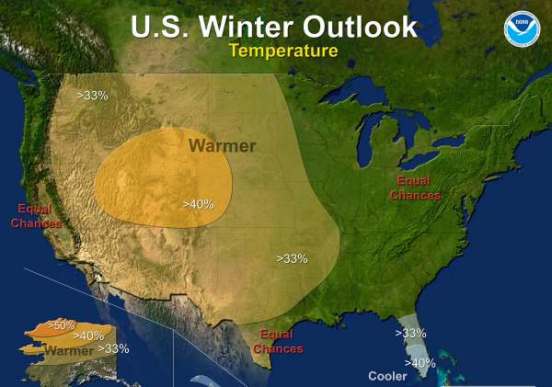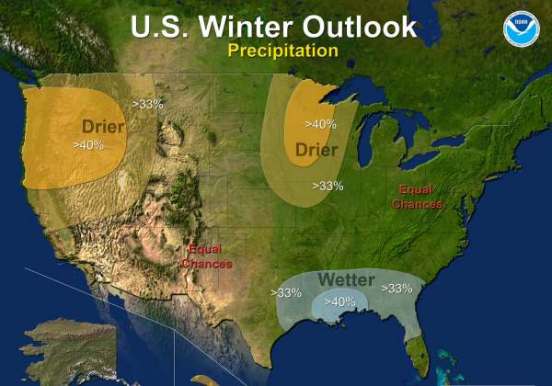Outlook
for Winter 2012-13:
Not remarkable, but forecast uncertain
After
a remarkable year in which North Americans coped with widespread
damage from Hurricane Sandy, terrific windstorms in June
and October, and a record-setting drought in most of the
nation, the winter of 2012–2013 (December, January,
February) may present few surprises. The US Climate
Prediction Center released new three-month and one-month
climate outlooks recently in October.

Most
of the nation west of the Mississippi River is expected
to be warmer than usual in the upcoming cold season, except
in California and along the Pacific Coast (map,
above left). This is in line with a warming trend in the
West that has lasted over twenty years. Very often, when
the West has been unseasonably warm, it has been drier than
usual. That may not be true this year for most of the western
states. But the Pacific Northwest from San Francisco to
British Columbia, which is typically dripping wet in the
cool season, is now expected to be drier than normal. This
dry spell is expected as far east asYellowstone Park. A
region centered on Minnesota is also expected to be dry
(see the map at right for the rainfall
outlook).
Continues
|
The
only states forecasted to have a cooler-than-normal winter
are Florida and Hawaii.
The
El Niño / La Niña oscillation, also known as
"ENSO," is often the main influence that
shapes the climate forecasts for future seasons up to one
year in advance. This time, ENSO did not make it easy for
the forecasters to settle on an outlook for the winter. The
ENSO is in a neutral phase, being neither El Niño nor
La Niña, and while some expect a weak El Niño
to develop at year's end, it has not happened. Nevertheless,
the expectation that it will happen is why the climate forecasters
expect a wet Gulf Coast this winter.
The
Climate Prediction Center cautioned that there is a lot of
uncertainty in this particular forecast. The maps shown here
are based largely on relatively new dynamical climate models
developed in the past few years, rather than a more traditional
analysis of well-known climate cycles like ENSO and the Pacific
Decadal Oscillation.
Next
Story: Sea Level
Fell in 2011

Return to Main Page |

